If you are a parent of a child and facing the loss of a beloved pet, you may be wondering how best to help your kid process the death of their furry best friend. End-of-life-care veterinarian Dr. Dawnetta Woodruff draws on her 19 years of experience to provide heartfelt advice and helpful tips to support kids who are experiencing the loss of a pet.
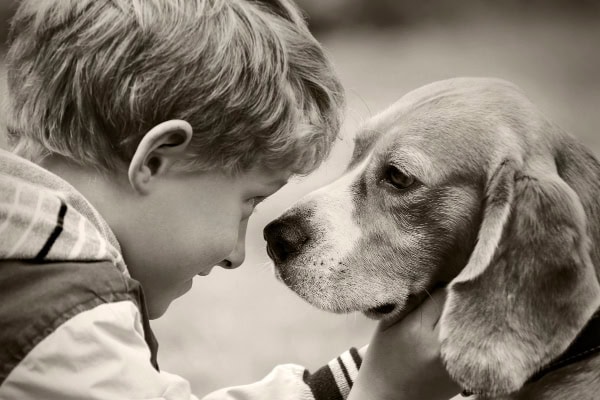
When you watch kids and pets interact, it becomes clear that animals and children often share incredible bonds. Plus, our pets are cherished members of the family. And they enrich our days with sweet companionship, laughter, and unconditional love! These strong human-animal bonds are a big part of why—whether you are an adult or a child— it hurts so much to say goodbye at the end of our pets’ lives.
The decision of when to euthanize a beloved pet is complex, and it is difficult to manage our own grief during this process. Yet as parents to human kids, we know that part of our job is to help and support them during the loss of a pet too.
Being adults, we know that our pet’s lives are short—10-13 years for a dog on average and 13-17 years for a cat. (These numbers can vary tremendously depending on life circumstances, breed, and genetics.) Those years together never last long enough, and we will always wish for more time.
However, for our kids the concept of time is much more abstract, and can be difficult to fully grasp. Also, a pet’s shorter lifespan means that the kids have likely spent much of their lives growing up with their animal friends. Young kids may not remember life without their pets. And older kids’ earliest memories may involve choosing a pet and bringing them home.
Preparing kids for the death of a pet
When facing the imminent loss of a pet, one of the biggest questions that parents often have is, “Should I tell my child that their pet is going to die?” Then, as a follow up they may wonder, “Should we allow our kids to be there for the euthanasia?”
The short answer is “yes” to both questions in almost every situation. Certainly there are unique circumstances that require a different approach, but most of the time honesty is best.
Sadly, many now-adults were not given the chance as kids to say goodbye to their childhood pets. This can leave lasting scars on the heart. Therefore, being honest and discussing death with our children is an important part of them learning to cope with loss. While the approach often differs based on age and maturity, the overall concept is the same.
1. Explain that not all sicknesses are curable
Talk with your children, and let them know that their pet has a sickness that cannot be fixed. It is important to explain that our bodies can fix most illnesses with time and some help from doctors and medication. However, there are illnesses that cannot be fixed, no matter how much loving care we give, and no matter how much money and time we invest. Coming to terms with this is important for us as adults, and it is important for kids to understand too.
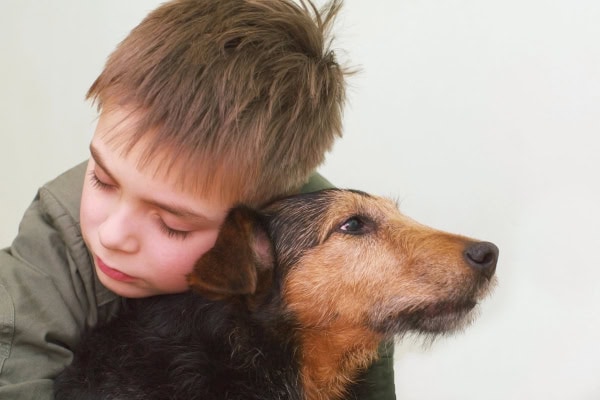
2. Talk about death
Once our kids know that their pet is sick or in pain and the problem is not fixable, we can talk with them about death. If you have religious beliefs, it is good to include your views as you discuss pet loss with your children. You may talk about your pet going to heaven, crossing the rainbow bridge, or simply being free of their painful, broken body. All of these things allow our kids to begin to understand what is happening.
3. Help your children make special memories with their pet
Before the euthanasia, it can help to involve our kids in making special memories (like a bucket list for their pet). Or they may like creating special dog memorial items. Your kids might want to help take photos, create a photo album, make paw print art, or even write a letter to their pet. These things can be difficult. But they are also a lot of fun, and create good memories during a difficult time.
Planning your child’s level of involvement in the actual euthanasia
If your pet passes suddenly, you may not have time in advance to discuss things like euthanasia. But if your pet is sick or in pain for a long time, it is important to ask your kids if they want to be present when their pet dies. Some kids have very strong feelings one way or another. And it is more of an individual choice than an age-determined decision.
Saying goodbye ahead of time but not being present during the euthanasia
Many children don’t want to be present for the visit itself, but they do want the chance to say goodbye. There are ways to allow that to happen regardless of if the visit happens at your vet’s office, at home, or at a hospice comfort center.
It can be helpful to ask the veterinarian ahead of time if the space will allow only a couple people or can accommodate the whole family. If your child does not want to be present, or space is limited, try to devote a small amount of time that day or the day before for your kids to say goodbye in their own way. They may want to snuggle, feed special treats, or read a book with their pet.
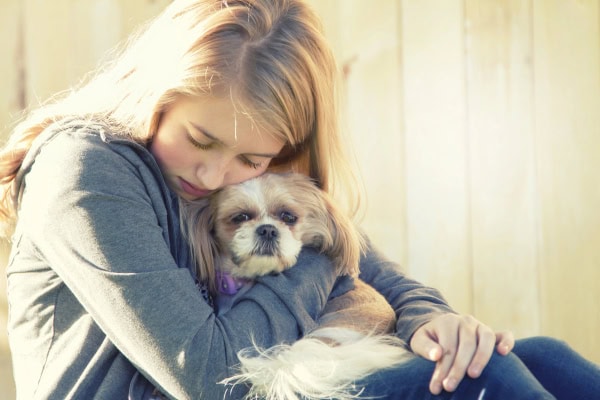
Being there during part or all of the euthanasia
If your kids are going to be present for the euthanasia, it is helpful to plan how things will go. Some children feel strongly that they want to be petting their beloved friend or speaking to them as they pass.
Other children want to say goodbye and not see the actual passing. They want to be present for part of the visit, but not the whole thing. Kids may choose to stay until sedation takes effect and their pet is sleeping. Or they may want to leave the room before anything “medical” happens.
If your kids are old enough to step away on their own, they can do so whenever they are ready. However, for younger kids, it can be beneficial to have a family member or a trusted friend present to sit with your kids. That way you can focus on being with your pet as long as you want to.
Figuring out if and how the adults want to be present for the euthanasia is important too
There is no “right way” to handle the decisions surrounding your pet’s passing. Each person is unique—both adult and child—and may wish to navigate their pet’s euthanasia in their own way.
Many people feel that they “have to” stay, but this is not the case. Your pet knows the love you have for them. Whether or not you are present for their final moments doesn’t change the years of love you have shared.
Some families have every person stay for every second of the euthanasia. Other families choose one person to stay, while the rest step out. Occasionally, no one in the family feels comfortable staying—and that is ok too. Your veterinary team will be sure your pet receives love and affection as they pass.
Consult with the veterinary team to understand the euthanasia process
If you have questions about the euthanasia process or what you and your kids might see, feel free to talk to your veterinary team beforehand. This aspect of preparing for your dog’s euthanasia helps you make an informed decision about what is best for everyone. Each veterinarian or veterinary clinic has slightly different methods. But they are all focused on giving your pet a peaceful and gentle transition from life to death.
Helping kids navigate grief after pet loss
It can be overwhelming to navigate our own grief while trying to help our kids. Many people expect grief to be a linear process that is predictable, with a distinct end point. However this simply isn’t true for most people.
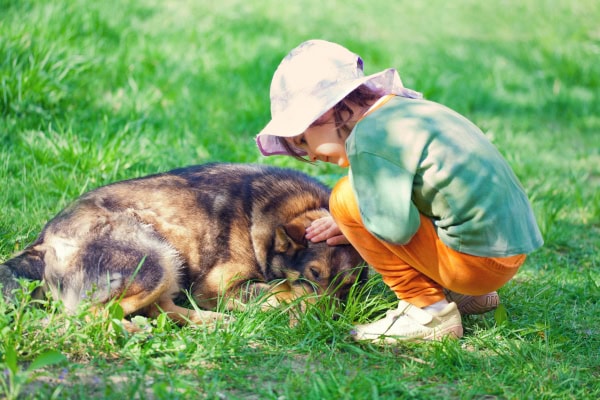
Grief often starts before your pet passes (anticipatory grief), and continues for weeks, months, or even years. This is the same for our kids. They pick up on our own fears and worries, and they are very observant. Kids will often notice a pet who is less playful, who moves slowly, or who hides away from the family and know that something is going on.
It is best to be honest with our kids, and have age-appropriate conversations that include them as we help our pets through their final days.
Know what to expect when a child is grieving the loss of a pet
After a pet passes, kids may have complex grief. They may be sad or angry for days, or even weeks. Their emotions will come and go, often unexpectedly. A child may appear to be “over it” one day (or one moment). Then they may have a very difficult time with sadness and anger in the next moment. This isn’t terribly different from adults; however kids are often more willing to express their feelings during the grieving process.
There is no specific order, timeline, or recipe for how to move through your own grief journey. This also means that there is no “one way” to help your kids. Each time you walk with them through the loss of a pet, the process will look different, and the time frame will change.
Asking for another pet
Kids are not shy about asking for another pet. In their mind, they know that their pet made them happy and brought joy. When they feel shock, sadness, anger, and depression, their natural tendency is to ask for another pet to “make everything better again.” They are not trying to replace the pet they lost. Rather they are trying to find a way to bring back the love and the happiness they felt when their cherished friend was alive.
Mentioning a pet’s passing at unexpected or awkward times
Kids will also speak about their feelings at awkward and random times. They may see a friend (or a random stranger) while grocery shopping, and blurt out “Did you know our dog died?” Or they may be playing with a friend and suddenly burst into tears, crying and asking to see their sweet kitty again.
These things are normal for kids, but can be awkward for us. It is helpful if we can expect these potentially uncomfortable moments and be prepared to work through them together. When they happen, we should acknowledge our child’s feelings, comfort them, and help them deal with their feelings in that moment, rather than trying to brush them aside or pretend they didn’t say anything at all.
Have conversations about grief with your child
Additionally, it can be useful to share our own emotions with our kids in a controlled and healthy way. It is ok to let them see our tears because it shows them that sadness and grief are normal. We can share with them when we feel sad and explain how we try to cope with the sadness.
For instance, you might say “I just found Bert’s old collar in this box. That made me sad. But it also reminded me of how happy he was when he got a new collar! Do you remember how silly he was, and how he would run around the house when he was excited?”
Letting our kids know that we feel sad and happy all at the same time can help them realize that their own complex mix of emotions is ok, too. Some days feel easier, and you can smile through the tears as you remember the funny and sweet moments with your dog. Other days feel almost impossible, and the memories of time with your precious kitty bring nothing but sadness.
This is expected, and it is typical of the grieving process. Knowing that our grief is normal can help our kids (and us) to feel less isolated and alone.
Understand that grieving looks different for kids at different ages and mental stages
Young children and older children will experience grief differently. Thus, the way your toddler handles pet loss may look very different from the things your teen experiences. However, older kids (and even adults) can often act younger than their age when it comes to grief—especially if it is the first big loss they have experienced.
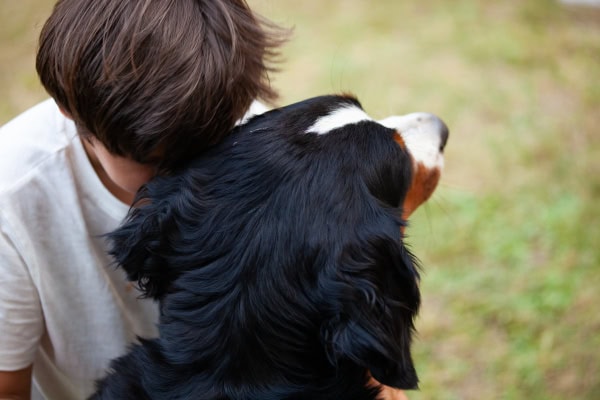
Allowing our children to feel the depth of their grief, and helping them to name their feelings can be very helpful when they experience other losses later in life. It is important that we talk openly with our kids, and help them in whatever ways we know how. Yet we also need to let them know that parents don’t always have all the answers. We want to “fix” our children’s grief, but sometimes we need help.
Seek outside help for a child who experienced pet loss
There are many pet loss support resources if we know where to look. A variety of websites, books, and pet loss products exist to help start a good conversation, or give you the words you need to support your children.
Share books about pet loss with your child
My favorite book about pet loss for children, and the one that is the most wide-reaching is My Pet Died: A Coloring Book for Grieving Children by Alan D. Wolfelt, PhD. However, there are many other books that you and your child may also find helpful. They are included in the table below…
Pet Loss Books for Children
These books are recommendations from Dr. Dawnetta Woodruff and not endorsements. It is advised for parents to read reviews of the book and read the book themselves prior to reading the book to children to ensure a proper fit to your family.
Always Remember by Cece Meng
A Rainbow Bridge for Gus: A Story About the Loss of a Pet by Barbara Rigabar and Chris Sharp
Bill at the Rainbow Bridge by Dan Carrison
Children and Pet Loss: A Guide for Helping by Marty Tousley
Cry, Heart, but Never Break by Glenn Ringtved
Death of a Pet by Shirl and J.W. Potter and George J. Koss
Don’t Say Goodbye, Just Say See You! by Patricia A. Brill, Ph.D.
Forever Paws by Christine Davis
For Every Dog an Angel by Christine Davis
For Every Cat an Angel by Christine Davis
Grief is a Mess by Jackie Schuld
Healing A Child’s Pet Loss Grief: A Guide for Parents by Wendy Van de Poll
Humphrey Was Here: A Dog Owner’s Story of Love, Loss and Letting Go by Mark Asher
I’ll Always Love You by Hans Wilhelm
My Pet Memory Book: To Help a Child Through the Loss of Their Pet by S. Wallace
Paw Prints in the Stars: A Farewell and Journal for a Beloved Pet by Warren Hanson
Remembering Baymore by Peter Gollub, DVM
Saying Goodbye to a Beloved Pet: A Workbook for Kids and Guidelines for Adult Caregivers by Wendy Young, LMSW, BCD
Saying Goodbye to Lulu by Corrine Demas and Ard Hoyt
Stay: A Girl, A Dog, A Bucket List by Kate Klise
Tear Soup by Pat Schweibert and Chuck DeKlyen
The Fall of Freddie the Leaf by Leo Buscaglia
The Goodbye Book by Todd Parr
The Heaven of Animals by Nancy Tillman
The Invisible Leash by Patrice Karst
The Next Place by Warren Hanson
The Tenth Good Thing About Barney by Judith Viorst
When a Pet Dies by Fred Rogers
Reach out to a counselor
If you feel your kids need to talk to someone other than you, it can be beneficial to reach out to a grief counselor who specializes in assisting with pet loss. Not everyone understands the depth of grief that comes with saying goodbye to a furry family member. Thus, it can be helpful to start by asking your vet’s office if they have recommendations for trusted counselors.
Together you and your children can get through the loss of a pet
No matter which support option you choose to help your family through pet loss grief, the important thing is to feel comfortable seeking help. Pets are amazing creatures with beautiful souls. It is natural for us and our children to feel a profound sense of loss in their absence.
Talking through grief, and allowing your kids to acknowledge its difficulty are good first steps towards healing your heart. As your family focuses on healing, the days will begin to feel a bit easier. And the joy will feel brighter again as you all remember your sweet pet’s life.
How have you helped your kids through the loss of a pet?
Please comment below.


We are about to have euthanize our 12yr old German Shephard/Rottweiler mix Dixie this week. she’d turn 13 in May. my husband and I got her while engaged in spring 2013 I was 8 weeks pregnant with our son n she was 8 weeks old. She’s been through everything with us the good & bad. She’s saved me on some of my darkest days. Our son is now 11yrs old and we’ve been 100% transparent with him bout this happening and he will be in the room with us. it just breaks my heart as he broke down last weekend crying and saying “I don’t know what I’ll do without Dixie in my life and I just wanted her to see me grow up mom!” He really don’t know life without her in it she’s been here since the day we came home from hospital. I try and hide when I get sad and cry where I’m not doing in front of him or his younger brother whose 5yrs old bc i dnt wanna get them all sad n upset. but I’m struggling bc I feel like I’m losing a huge part of my heart also. she’s not just a dog to me she’s one of my kids.
Dear Tesla,
My heart aches for you with your recent loss of Dixie. It is clear she was dearly loved, and I am certain she knew. I hope with time your heart can begin to heal and pray for peace for you and your boys. May Dixie’s memory live on and continue to be a blessing in your life. ♥
I accidentally ran over a 7 year old girls dog. It died instantly. It was a small Chihuahua and had gotten out of their house and ran right in front of my car on a busy street. These people and I are strangers. I felt so bad and expressed my sorries to the girl and her mom. I know where they live and am looking for advice on what to do for them, or just leave it go. This was about a week ago.
Dear Thomas,
I am so sorry you experienced this tragic situation. Please don’t be too hard on yourself. It was an accident and sometimes life is just cruel. If you wanted to leave a card or some small trinket for the little girl that would be appropriate. But I also don’t feel like you are obligated to do anything beyond what you have already done, which was offer your sincere apologies and sympathies. Just the fact you took the time to write this comment and leave it for all to see shows me what a good person you are at heart. Praying for comfort and peace. Bless you friend.
We just had to euthanize our 13 year old Husky Hunter on February 6th. We don’t have any kids but I am struggling with the grief. These last two years he required more care due to his arthritis in his back legs. We did everything we could for him to make his final years more comfortable. My husband would leave for work first in the morning so I was the one giving his meds and feeding him and he was always by my side: The sadness, emptiness and loneliness I am feeling is overwhelming and all I do is cry.
Dear Angie,
My heart aches for you as you grieve the loss of your beloved pup. I can only imagine how much you miss Hunter and how strange it must be without him by your side. I will attach links to other articles that I hope will offer comfort, support, and sympathy. Praying for peace and wishing you brighter days ahead. ♥
1. Grieving the Loss of a Dog After Euthanasia (& Finding Peace)
2. Pet Loss Support: Groups & Resources for Comfort
3. Dog Memorial Ideas: 10 Ways to Honor Your Dog’s Legacy
I was the child whose pet was euthanized and wasn’t told until later. I am commenting to say TELL YOUR KIDS THE TRUTH. You don’t have to get into every detail, but be honest and open with them and don’t hide it.
Dear Sarah,
I am sorry for the negative memories you have surrounding the loss of a beloved pet. I agree and hope we can get this message out to others. Thank you for speaking out and sharing your thoughts. ♥